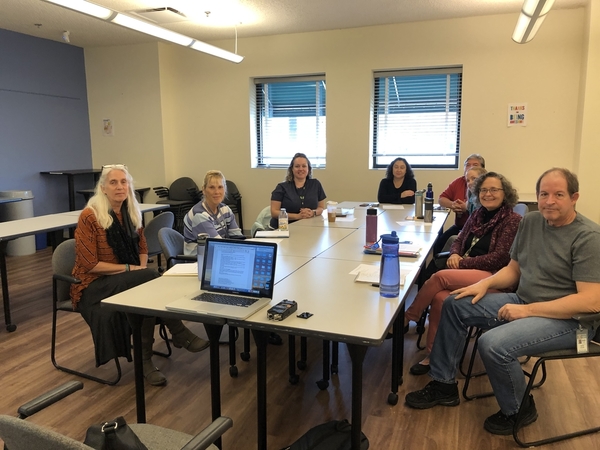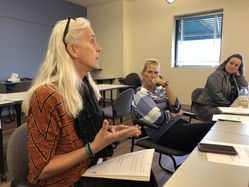Santa Rosa, CA, resident Lisa Marden watches her 15-month-old baby gleefully play with magic markers and relays how she’s been coping with feeling anxious. (We're using a pseudonym to protect the family's privacy.)
“I’m just super stressed out with everything, and as soon as I eat anything, I get nauseous, so I’ve been eating snacks instead of meals,” she explains to Liz George, a field nurse with the Maternal/Child Field Nursing team of Sonoma County, CA, who has been seeing Marden on home visits for the past 18 months. “There’s nothing wrong with that as long as what you’re having is nutritious.”
Marden remembers that she felt an immediate trust working with George. In fact, George was the first person Marden called when she was being abused by the father of her toddler. “If she hadn’t [called CPS], I wouldn’t have had the courage to leave a domestic violence situation,” says Marden.
During the previous night, she used the sound of ocean waves from a music app to settle her rattled nerves so she could sleep. George praises Marden for actively finding a way to calm herself down.
Encouraging such activities may seem minor, but it’s central to an approach that George and her colleagues implemented in a pilot program in July 2018. The approach, which is discussed in a recent article in the journal Public Health Nursing, focuses on educating families about the science of adverse childhood experiences (ACEs), and how severe and relentless stress from ACEs impacts the brain, child development and health. It also provides guidance to parents on ways they can heal from their own traumatic experiences and prevent or mitigate passing on ACEs to their children.

The term ACEs comes from the groundbreaking Adverse Childhood Experience Study (ACE Study), first published in 1998 and comprising more than 70 research papers published over the following 15 years. The research is based on a survey of more than mostly white, middle- and upper-middle class 17,000 adults and was led by Drs. Robert Anda and Vincent Felitti. The study linked 10 types of childhood adversity — such as living with a parent who is mentally ill, has abused alcohol or is emotionally abusive — to the adult onset of chronic disease, mental illness, violence and being a victim of violence. Many other types of ACEs — including racism, bullying, a father being abused, and community violence — have been added to subsequent ACE surveys. (ACEs Science 101; Got Your ACE/Resilience Score?)
The ACE Study, an epidemiological analysis of childhood adversity, is one of the five parts of ACEs science, which also includes how toxic stress from ACEs affects a child’s brain, the short and long-term health effects of toxic stress, the epigenetics of toxic stress (how it’s passed on from generation to generation), and research on resilience, which includes how individuals, organizations, systems and communities can integrate ACEs science to solve our most intractable problems.
The need for a trauma-informed approach took on a particular urgency in Sonoma County in 2017, when many thousands of people lost homes, livelihoods and their communities to the ravages of the 2017 fires. Clearly there was going to be a need for ongoing assistance on many fronts. The field nursing team was there to help, but it wasn’t systematically using an approach that was informed by ACEs science.
What was needed was the kind of focus that’s at the core of the NEAR@home program, a home visiting curriculum that was developed in 2015 byThriveWashington, a youth advocacy group in Washington state, and has been used internationally, according to a report by the organization. The purpose of the program is to help families understand the generational transmission of ACEs and how parents can prevent and mitigate ACES in their children. In the case of the Sonoma fire, such an approach would have been enormously useful in helping victims deal with the potential long-term psychological consequences of the tragedy for them and their children.

It turns out, this is exactly the kind of thing George had been championing since she first became familiar with ACEs science several years earlier, when she heard ACE Study principal co-investigator Dr. Vincent Felitti speak in Sonoma County. “I sat through that presentation, and I thought ‘Holy shit!! That’s all my clients and, oh my god, that’s me!’ And it just made so much sense!” In fact, after this but before the fire, George had already trained 19 colleagues — including nurses, social workers and other staff — in ACEs science and strategies for introducing conversations about ACEs. The participants were also taught how to use the ACEs questionnaire, which assigns a score to each participant based on how many of the adverse experiences they had as a child.
After the fire, Julianne Ballard, who supervises the field nurse program, worked with George to set up a pilot program to standardize and document the ACEs science approach in the hopes of establishing an evidence-based model for field nursing in Sonoma.
For the pilot study, which began in July 2018, the Sonoma County field nursing team collected ACE scores from 73 parents, including Marden. Sixty-five percent reported ACE scores of 3 or more. Compared with an ACE score of zero, an ACE score of 4 nearly doubles the risk of heart disease and cancer, increases the likelihood of becoming an alcoholic by 700 percent and the risk of attempted suicide by 1200 percent. The families included parents who, like Marden, may have survived a violent relationship (47%). Or they may have used drugs (42%), as Marden did to cope with the grief of losing her husband in the Iraq War. The drug use and the way her life spiraled down eventually landed Marden in jail and cut off from her children.
Each of the participants received 12 visits from a public health nurse within a six-month period, during which the nurse would promote things like mindfulness, the importance of sleep, good nutrition, strong relationships, exercise and mental health support.
Marden says she first met George at a community health clinic while she was still in jail. “She just lets me talk about what I need and want, and not just the bare necessities. She goes above and beyond. She throws her full heart in it, and that makes me feel good.”
Marden ticks off a list of other beneficial things that she does now, like running daily, reading every morning from a book of positive affirmations, crocheting to calm anxiety and having picnics and playing with her baby in the park. And she hasn’t used methamphetamines for two years. All of this ensures that she’s better able to give her baby a better chance of going through life without trailing her own high ACE score.
And Marden is not alone in feeling the benefit of the healing-centered approach that uses this new knowledge of ACEs science. Of the 73 families that participated in the pilot, they all reached 80 to 100% f the program’s goals, which include: ensuring that families have health insurance and regular access to medical care for themselves and their children (including pre-natal care), childhood immunizations, treatment for parental depression and early interventions for developmental delays in their young children.
Indeed, the program has been so successful in the short term that come July, San Francisco, Stanislaus and Napa counties will begin piloting the Maternal/Child Field Nursing model, and Sonoma County will continue its pilot to examine longer-term outcomes with the help of researchers at UCSF.
For her part, Marden says she hopes to return to school and become certified to work with women who have survived domestic violence and struggled with addiction. And perhaps most importantly, she knows how to ask for help.
“I used to isolate myself, and didn’t reach out to people, and I don’t feel like I’m a burden to others,” she says. “When I feel triggered to use [drugs], I call people or go to a [Narcotics Anonymous] meeting. Because no way am I going to lose my kids and everything I worked for.”



Comments (0)